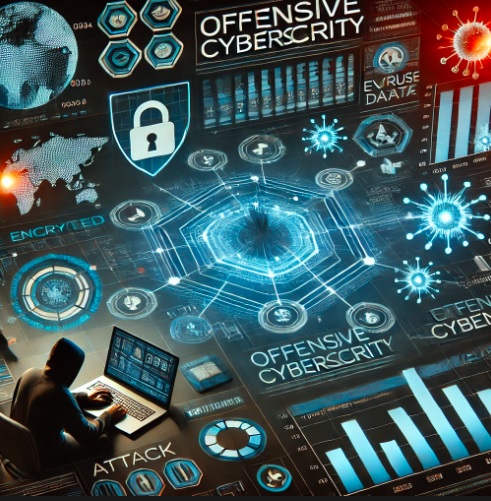The stakes for your company this year are higher than ever, with more risks than ever before and the cost of breaches surging.
Accepting a proactive offensive cyber security approach is essential to improving your security posture.
Let’s discuss how you can maximize offensive security investments and efforts in the upcoming year and how to define proactive security goals.
Overview of Cybersecurity Sector
A key element of the contemporary digital world, the cybersecurity sector is distinguished by its rapid expansion and changing set of problems.
This section provides a basic knowledge of the sector’s current situation and future perspective by examining important facts that shed light on the industry, such as workforce size, salary patterns, and educational requirements.
In terms of ensuring that “users of connected devices and related technologies are protected against cyberattacks,” only 4% of firms are confident in their security.
- The expected number of workers in the cybersecurity field worldwide is 4.7 million.
- Numerous news from the cybersecurity business in 2024 are predictable and have now become themes across a number of years
Attacks Using Ransomware Are Become More Frequent
Cybersecurity accountability is becoming increasingly important to the federal government.
Companies are paying a higher price than ever for breaches.
They raise the question, “What should we be doing to respond to these trends?” even though they are not surprising.
The most crucial response is for companies to intensify their emphasis on investments and proactive initiatives this year.
Offensive security should be one of the most important takeaways.
The first thing to remember is that everyone should do it since it’s highly beneficial and helps you prioritize. It’s also becoming more and more necessary, which is a good thing.
Although it hasn’t been around for more than 20 years, ransomware is still a menace. Ransomware is thought to contain over 120 distinct families at this point, and hackers have gotten quite good at concealing harmful code.
Ransomware’s popularity can be partially attributed to its ease of use as a means of financial gain for hackers. The pandemic caused by COVID-19 was another reason.
Along with remote labor, an increasing number of firms have gone digital, giving ransomware additional targets. This led to an increase in the number of attacks and the size of demands.
Extortion attacks entail hackers taking advantage of a company’s data and encrypting it to prevent access.
After then, hackers threaten to reveal the company’s confidential information unless a ransom is paid, thus blackmailing the corporation.
Because sensitive data is at risk and paying the ransom will have an adverse effect on finances, this cyberthreat carries a heavy cost.
The Reasons for Using an Offensive Security Strategy
To test defenses and ensure strong protection against actual threats, offensive security solutions use simulated attacks.
This functions effectively even in situations when it’s difficult to distinguish between computer systems, the Internet, and IT networks—such as when cloud computing has blurred such lines.
Considering the ramifications of data breaches, it makes more sense to invest in offensive cyber security solutions rather than pay for remediating expensive data breaches.
OFFENSIVE CYBER SECURITY TRENDS
Adapting Operating Models for Cybersecurity
Conventional cybersecurity operational paradigms are being disrupt by the ongoing movement of technological assets from central IT into business sectors.
In response, cybersecurity leaders are changing their operational models.
Specifically, they are equipping resource owners with the skills and procedures they need to manage their resources locally.
The Internet of Things is Constantly Changing
The proliferation of the Internet of Things (IoT) opens up new avenues for cybercrime. The term “Internet of Things” describes physical objects. it is connect to the internet and exchange data, excluding computers, phones, and servers.
Wearable fitness trackers, smart refrigerators, smartwatches, and voice assistants like Google Home and Amazon Echo are a few examples of Internet of Things products.
64 billion Internet of Things (IoT) devices are projected to be installed globally by 2026. This rise is being aided by the move toward remote work.
The dynamics and extent of what is commonly refer to as the cyber-attack surface—that is, the number of possible entry points for bad actors—are alter by the abundance of more devices.
Most IoT devices have less processing and storage power than laptops and smartphones.
Variety of Targets
Traditional targets like big businesses and government organizations are no longer safe from digital threats.
These days, the main targets are individuals, healthcare organizations, educational institutions, and smaller corporations.
The motivation for this diversity of targets is the aim to cause trouble or pilfer important personal data.
State-Level Players
The digital threat landscape has taken on a new dimension due to the engagement of nation-state actors in cyberwarfare and espionage.
Governments make significant investments in enhancing their cyber capabilities, and some of the most well-known attacks in recent years have been carried out by state-sponsored hacker organizations.
These assaults may muddy the distinction between conventional and cyberwarfare and have geopolitical repercussions.
Retraining in Cybersecurity
Cybersecurity leaders must constantly address the worldwide talent gap in the field by retraining current employees.
This is especially in “adjacent” skills, and employing new employees with fresh backgrounds, some of which emphasize soft skills.
Reaction and Fortitude
It is now crucial to develop resilience and event response plans that work.
Preventing attacks and identifying, minimizing, and recovering from security breaches are the priorities for organizations.
This entails consistent security evaluations, personnel education, and strong incident response protocols.
Lastly, Offensive Cyber Operations: Ethical Considerations
When conducting offensive cyber operations (OCO), it is important to keep in mind that moral responsibility, accountability, adherence to ethical principles. And compliance with national and international laws are all ethical considerations.
Additionally, it is important to make sure that OCO activities are carrying out within recognized legal bounds. The following ethical considerations must keep in mind when conducting offensive operations:
- Adherence to International regulations: In order to maintain legal compliance, security specialists must abide by a number of international regulations, including the Law of Armed Conflict (LOAC).
- Moral Responsibilities: People who engage in offensive behavior ought to uphold moral principles and accept accountability for their deeds.
- Authorization: It is the responsibility of offensive cyber security specialists to carry out security operations on designated targets only after obtaining the necessary consent.
- Vulnerability Disclosure: Transparency requires accurate disclosure of the type of vulnerability and its possible effects.
- Ethical Decision-Making Tools: To guarantee that OCO operations are carried out morally within a compliance framework, ethical decision-making tools can assist in providing direction.




